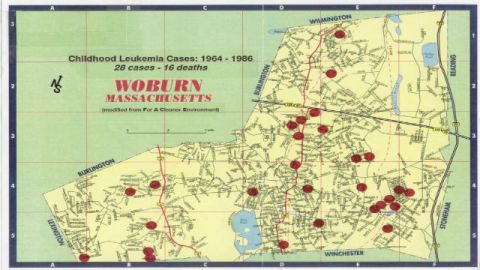Toms River, Woburn, and the sad lack of clean answers about ‘Cancer Clusters’

Dan Fagin’s new book “Toms River, A Story of Science and Salvation”, about a classic type of environmental story back in the 80s and 90s, the ‘cancer cluster’, is a well-written history about the extensive chemical pollution in the Toms River New Jersey area decades ago, rich in detail about the scientific detective work required to figure out whether all that pollution did anything to people’s health.
But the subtitle suggests there was ‘Salvation’, and as anyone who has lived in a cancer or disease ‘cluster’ community can tell you, and as Dan reports that the people in Toms River discovered, salvation really never comes, at least not if by salvation you mean a clear answer to the key question the people in these fearful communities ask; is something in the environment making me sick. During my years as a daily journalist I reported on several of these communities, and none of them ever had that question clearly answered.
– I can still hear the sadness in the voices of Anne Anderson and Donna Robbins and Mary Toomey and the other parents in Woburn who believed industrial solvents in the town’s water had killed their kids…more than a dozen kids dead of leukemia in just their one small neighborhood.
– I recall the courage of the parents of autistic kids in Leominster, who suspected that the unusually high prevalence of autism in their area was caused by the plastic industry’s activity there years before.
– I remember the conviction among the parents in Lowell that the industrial chemicals oozing from those rusted barrels on the Silresim hazardous waste site had caused the concentration of respiratory problems in the neighborhood, in kids and adults.
And I remember the universal anger these people felt about what had been done to them, because certainly, they felt, so much similar illness in such a small area could not be a matter of chance alone. I remember their fierce certainty that the unusual cluster of illness and death had to be somebody’s fault, and their powerful need for research to confirm their belief that pollution had poisoned their kids. That confirmation never really came.
– – –
‘Cluster’ stories were tough to cover for reporters with no background in epidemiology, toxicology, hydrogeology, and the other advanced scientific methods necessary to unravel these complex puzzles. We had no training in statistics either, so what seemed to parents like a cluster, an unusually high number of cases in one small area, looked that way to reporters too, even though “chance” is not nice and smooth (at least not on the narrow scale of time and location these clusters represented), and sometimes the coin can come up tails ten times in a row, and sometimes disease clusters are nothing more than random bad luck.
But the hardest part of these stories was not the scientific complexity, and not even sharing the terrible sadness these parents were coping with. The hardest part of cluster stories was that they never neatly ended. They never produced ”The Answer”, because even in the few cases when disease clusters were more than chance, proving whether contaminated air or water had anything to do with the illnesses was practically impossible, even for the best scientific research methods. As Fagin notes in “Toms River”, the number of victims was usually too small to be confident about any pattern between potential cause and effect that research might uncover. The research was trying to unravel what had happened decades ago, so accurately estimating the parts per million of chemical contaminants that people might have been exposed to, based in large part on their memories, and scientifically recreating how those contaminants got from where they were dumped or emitted into the stomachs or lungs of the victims, was far too imprecise for any firm conclusions. (The inability of science to answer these questions is why the Woburn families’ lawsuit, the subject of the book and film A Civil Action, settled without a verdict. The Tom’s River case brought by 69 families against the polluters settled out of court too.)
Here’s how hard it was to get to the bottom of these cluster cases. A 2012 review of 428 full-scale epidemiological cluster investigations across America since 1990 initiated in response to public concern, a sweeping body of ‘citizen epidemiology’ that Anne Anderson and Woburn had helped pioneer, (Cancer clusters in the USA: What do the last twenty years of state and federal investigations tell us?), found only three that established some connection between pollution and illness; Tom’s River, a lung cancer cluster in a small area of Charleston South Carolina – home to a lot of former shipyard workers who had been exposed to asbestos on the job, and Woburn.
And even in Woburn, the most ‘conclusive’ of the three, the results hardly provided the clear resolution the parents wanted…that they needed. After several studies produced inconclusive results, one investigation, conducted long after the famous court case was over, A case-control study of childhood leukemia in Woburn, Massachusetts: the relationship between leukemia incidence and exposure to public drinking water, finally established that “…the relative risk of developing childhood leukemia was greater for those children whose mothers were likely to have consumed water from wells G and H (which had been contaminated by industrial solvents) during pregnancy than for those who did not.” In other words, the pollution may have killed the kids (tragically, because mothers unknowingly had exposed their fetuses just by drinking town water). But the authors quickly cautioned “Our limited ability to demonstrate (statistical) significance warrants cautious interpretation of the precise magnitude of risk.” Meaning that the sample of less than two dozen victims was too small to be sure about the results.
There are many lessons in Dan’s book and all those disease cluster stories I covered. One is that we just don’t have the scientific tools to prove with reasonable certainty what common sense seems to suggest, that local pollution can cause local clusters of disease. The clusters may be out there, but science can’t confirm them. As Dan suggests, and the scientists who reviewed those 428 mostly inconclusive cluster studies said; “There are fundamental shortcomings to our current methods of investigating community cancer clusters.” Few of these full studies are even done anymore.
Another lesson is that tragedy and emotion are powerful lenses through which people see circumstantial evidence about risk, and sometimes we jump to conclusions that feel right and seem to make sense, but which the factual evidence just doesn’t support. Sometimes a geographic cluster of disease victims really is just rotten luck. And sometimes our subjective, emotional perceptions of risk lead us to fear the wrong thing, the one that feels scariest and which fits the accepted narrative about environmental risks (e.g., hazardous waste sites are harmful), but which does not match the evidence. They did a full study of the Lowell neighborhood with the breathing problems near the Silresim hazardous waste dump that everyone, including us journalists, was sure was the cause. It turned out the cause was a nearby factory that occasionally used a chemical sealant on the raincoats they made. The hazardous waste dump had nothing to do with it.
Finally, and sadly, Toms River and Woburn and Leominster and Lowell and hundreds of communities across the country worried that something in the environment caused an unusually high threat of disease, have taught us that the combination of subjective risk perception, and the inability of science to provide firm answers, leaves the people in these communities caught in a frustrating emotional limbo that never cleanly ends, but just peters out in a sad resigned acceptance that the truth will never be known. And that is far short of the resolution – the salvation – these people deserve and so desperately seek.





